Middlesbrough, North Riding of Yorkshire
From 1837 until 1875, Middlesbrough (frequently misspelt as 'Middlesborough') was part of the Stockton Poor Law Union. Following the development of iron mining in the area, the population increased substantially. As a result, a new Middlesbrough Poor Law Union was set up, taking in parts of the existing Guisborough, Stokesley and Stockton unions. The new Middlesbrough Union formally came into being on 25th June 1875 and comprised the townships and parishes of Eston, Hemlington, Ingleby Barwick, Linthorpe, Maltby, Marton, Middlesbrough, Normanby, Ormesby, Stainton, Thornsby, and West Acklam. The first meeting of the new Middlesbrough Board of Guardians took place on July 29th, 1875.
The new union was formed at a rather inopportune time, with unemployment in the area being exceptionally high in 1875-6, and again in 1879. Before a new Middlesbrough union workhouse was ready, about 300 Middlesbrough paupers had to be housed in workhouses belonging to the neighbouring unions of Darlington, Guisborough, Stokesley and Stockton. As an alternative to the workhouse, three 'labour test' yards were set up, one at the new workhouse site, one near the railway station, and one elsewhere. The yards allowed poor relief to be given in return for the performing of manual labour — usually stone-breaking. In February, 1878, it was recorded that 382 men were at work in the three yards. Unfortunately, the union found it difficult to dispose of the broken stone and by mid-1879 had over £4,000 worth on their hands.
St Barnabas Road Workhouse
A new workhouse was erected in 1877-8 on a 15-acre site between New Cemetery Road (now St Barnabas Road) and Ayresome Green Lane which was purchased for the sum of £6,750.. The design was opened to competition for which prizes of £100 and 50 were offered. From the 24 entries, the plans submitted by Perkin and Sons of Leeds were chosen. Their design included a 200-foot-long corridor plan main building at the south of the site, and a pavilion-plan hospital and school at the centre and north of the site respectively. The foundation stone for the workhouse was laid on August 2nd, 1877, and the first intake of thirteen inmates were admitted on 23rd December, 1878. The main building was planned to accommodate up to 726 inmates. By September, 1879, 390 paupers had been brought back from the neighbouring unions to take up residence in the workhouse.
The workhouse location and layout are shown on the 1870s map below.
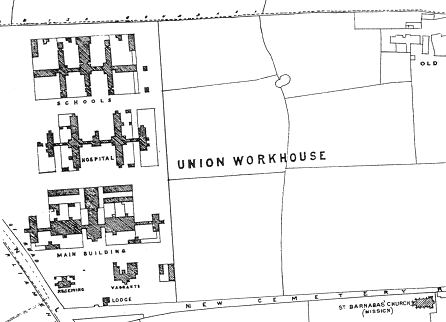
Middlesbrough workhouse site, 1878.
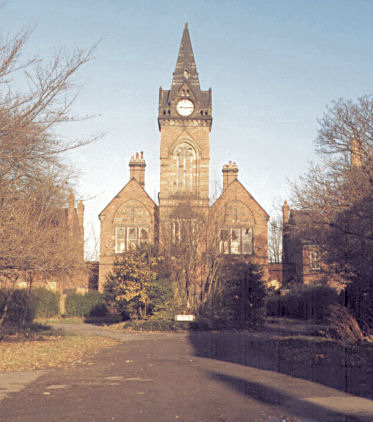
Middlesbrough workhouse main building from the south, 1980s.
© Alison Brown.
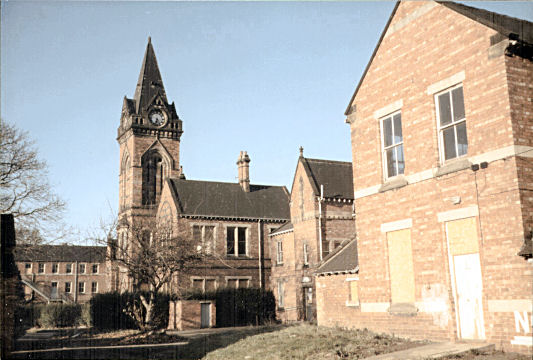
Middlesbrough workhouse main building from the south-east, 1980s.
© Alison Brown.
The hospital building, situated 60 feet behind the main building, had 120 beds. It comprised a central administrative block linked by covered walkways to the men's pavilion at the east and women's pavilion at the west.
The schools building, to the north, contained school-rooms, day-rooms, dormitories, and play yards. It was intended to accommodate around 200 children aged two to sixteen years. Somewhat unusually, the facilities also included a swimming bath. In 1887, an eight-year-old girl named Jane Wilson drowned in the bath after being left unattended for a short time.
In its first few years, the workhouse was often half-empty, although the severe trade depression in the years 1884-7 led to the winter population rising to around 800, reaching a peak of 813 in December 1886.
The union continued to offer relief to able-bodied men through test work in the labour yard. For this, single men received four shillings a week and men with families received twelve shillings. In December 1887, plans were drawn up for a more permanent labour test yard. This was constructed in 1888 at the north-east of the site and took the form of a large square. The buildings on one side included workshops, a day-room, dormitories, and a Test Master's house. Another side of the square comprised a building with 24 cells, 12 on each side of a corridor with tables for corn-grinding. The two remaining sides were made up of seven-foot-high walls.
In its first decade of operation, the workhouse and Board of Guardians were on the receiving end of many complaints of mismanagement. In July 1875 the Relieving Officer for the Middlesbrough District was prosecuted for embezzling funds belonging to the Stockton Union. The workhouse master, Robert Bray, was a strong-willed, domineering man who often provoked complaint. In December 1883, for example, one Guardian referred at a Board meeting to 'another exhibition of vindictiveness on the part of the Master towards the Porter'. In 1884, he was involved in a court case for refusing to allow an inmate with chronic diarrhoea to have medical treatment at the Workhouse Hospital and for having him put in a police cell overnight after the pauper had complained about his treatment. Reprimanded by the Magistrates and later the Guardians, no further action was taken, however. The following year it was discovered the Master had allowed his grown up son to live in the Workhouse rent free for several years, and it took much persuasion by the Guardians to get his father to pay 15/- per week to the Board for his keep. (the 1881 census, four years earlier, had listed this son as a 'visitor'). In 1886 when Bray died, this son became the Master of the Workhouse at the age of 28.
Worse was to come. In 1880, a young child was burned to death because there had been no fire screen. In 1882, an 'aged and decrepit female' was found wandering in Stockton after an arbitrary discharge from Middlesbrough Workhouse. A year later, three pauper children were found in a Middlesbrough Street by a clergyman after being simply 'put out from the House' with nowhere to go. In 1887, a child drowned in the plunge bath in the Schools block, it being discovered later that one or two inmates had sole charge at the time of seventy children in the bath. The most serious criticism came in 1888 when a report on a fever epidemic in the workhouse revealed appalling sanitary arrangements in the main building. The Medical Officer of the Local Government Board concluded after his enquiry that 'not only were the scandalous faults and condition of the drainage of the Workhouse a cause of the spread of the malady through the buildings, and the very high fatality of the cases treated there but were the main cause of it'. Death from fever in the House was higher than in many parts of the town. It was revealed too that existing plans of the workhouse drainage system in the hands of the Guardians were very inaccurate and not up-to-date. In some places, an independent report showed pipes were not connected to main sewers and sewage simply ran into the foundations of the building settling as best it could.
By the mid-1890s, Middlesbrough had become the most populous union in the North Riding, and its workhouse and hospital were severely overcrowded. As a result:
- A new three-storey infirmary and nurses' home were erected at the east of the Schools building. The new building also provided space for four aged married couples to live together.
- A small building was erected at the extreme north-west of the site for up to 100 children of 'ins-and-outs.
- The laundry, kitchens and staff accommodation were considerably extended.
- A lunatic ward for four inmates (two male, two female) was erected to the north of the existing receiving house.
- Wood-chopping sheds were erected at the south of the labour yard, and the saw-mill relocated there, to form what became known as the 'stick-house'.
- A new children's hospital was erected at a separate site.
The enlarged workhouse layout is shown on the 1928 map below.
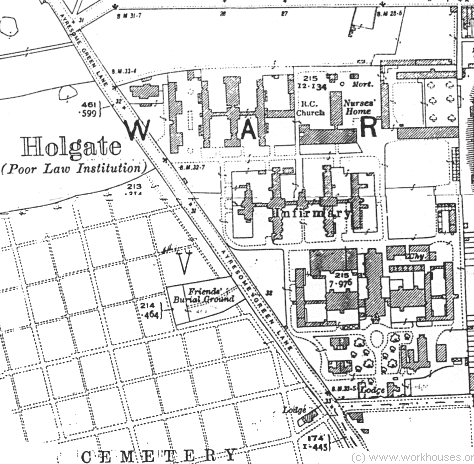
Middlesbrough workhouse site, 1928.
In parallel with the new building scheme, the Middlesbrough Guardians carried out an appraisal of the workhouse running costs. In February, 1899, a deputation visited the workhouses at Gateshead, Newcastle, and South Shields. Their report showed that the average weekly cost per pauper for 'provisions, necessaries, and clothing' in the other unions ranged from 3s.4d to 4s.3d. compared to Middlesbrough's 4s.9d. This, it was suggested, was due to Middlesbrough's dietary being 'unnecessarily lavish'. Newcastle, it was reported, had three 'meat days' (as opposed to 'soup days') per week compared to Middlesbrough's two, but used much cheaper Australian tinned meat. Newcastle even recycled the meat tines by making them into drinking cans for use in the workhouse.
In 1903, before the new building works were complete, a Local Government Board inspection praised the general condition of the workhouses and its 'efficient and capable management'. However, the infirmary wards were crowded, particularly on the male side, and there was a complete absence of day-rooms. It was also noted that there was no hearse to transport the dead to the local cemetery.
In 1908, the test labour yard was enlarged to allow more than the usual 60 able-bodied men to be given test labour. The daily labour requirement at the date was to break either a ton of whinstone or 15 hundredweights of slag, or to grind corn, saw wood, or cultivate the garden for eight hours. In return, a man with a wife was allowed 7s. per week, going up to 15s. if he had six or more children. Half the payment was in money, half in kind, such as food. By comparison, the neighbouring Stockton Union paid a man and wife 6s. a week, and no-one aged 60 or over was offered test labour. On New Year's Day in 1909, men in the Middlesbrough Test yard were given the unheard of luxury of a day off with pay.
The population of the workhouse reached a peak of 965 during the national miner's strike. However, the approach of the First World War in 1914 benefitted local industry and numbers in the workhouse fell dramatically, down to 360 by May 1918.
By 1930, the workhouse had a wireless whose increased use was being recommended by the Visiting Committee. There were even occasional cinema shows in the main building where the projectionist received a fee of 6s. a performance and the Labour Master who assisted received 2s.6d.
After 1930, the main building of the former workhouse became a Public Assistance Institution known as Holgate Institution. Inmates, or 'residents', were now divided into three categories:
- Class A - aged inmates of good character and clean habits. These were allowed armchairs instead of forms in their day-rooms, could dine in their day-room rather than the dining-hall, had an improved diet (including 'puddings daily and cake twice weekly for tea'), had better clothing ('all tweed suits'), and given daily passes, tobacco, and newspapers. Old women in this class were also allowed a quarter pound of boiled sweets a week.
- Class B - mainly aged and infirm men. These were allowed forms or upright chairs, had to dine in the dining-hall, had passes for Saturday afternoons and one other day per month, and received tobacco and daily newspapers.
- Class C - able-bodied men 'not of good character or clean habits'. These had to sit on forms, always ate in the dining-hall, received a pass once per month, and 'tobacco for special work only'.
Of the 415 inmates recorded on one occasion, 38 were in Class A, 176 in Class B, and 201 in Class C. After 1948, the Institution became an old people's home until 1974 when it was then used as an adult training centre. Most of the main workhouse building was demolished in the 1980s.
After 1930, the hospital and school portions of the workhouse became the Middlesbrough Municipal Hospital, later Middlesbrough General Hospital. The main building was demolished in the 1980s.
Children's Homes and Hospital
From around 1900, Middlesbrough used a variety of homes for accommodating pauper children away from the main workhouse. In 1900, the Broomlands cottage homes for 36 children were erected at the south side of Cambridge Road, at a cost of about £5,000. At the same time, a 35 bed children's hospital was erected on an adjacent site at a cost of £6,200. The homes and hospital site are shown on the 1920 map below.
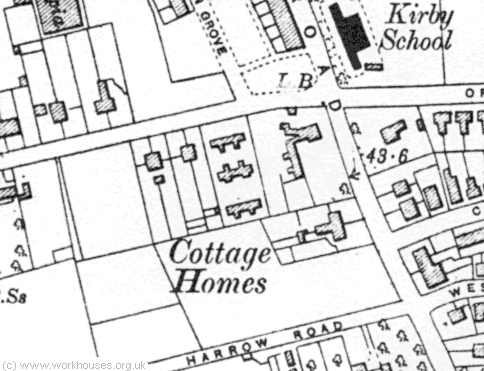
Middlesbrough cottage homes and hospital site, 1920.
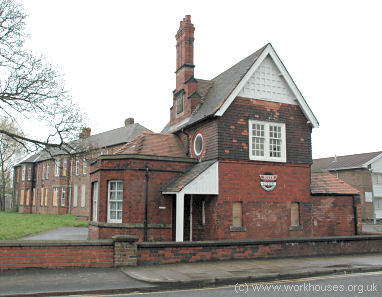
Middlesbrough children's hospital lodge from the north-east, 2005.
© Peter Higginbotham.
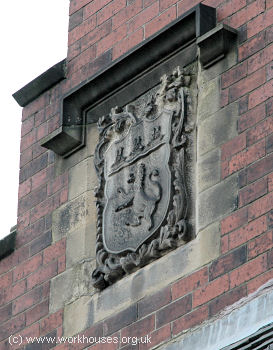
Middlesbrough children's hospital lodge, 2005.
© Peter Higginbotham.
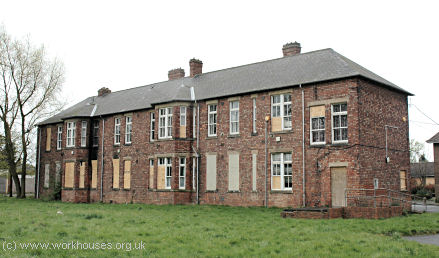
Middlesbrough former children's hospital from the north-east, 2005.
© Peter Higginbotham.
By 1913, the union had fifteen scattered homes in operation — three at 400-404 Linthorpe Road, three at 91-95 Grange Road West, two at 76-78 Grange Road East, one at Thornaby, and the six at Broomland's cottages. One of the Broomlands cottages was used as a receiving home for children coming into the union's care. A new receiving home was later established at Ayresome Green Lane, Middlesbrough, perhaps on the workhouse site.
In more recent times, the Broomlands site was used as a youth assessment centre. In 2005, the cottage homes no longer existed but the hospital and lodge were standing empty.
Staff
Inmates
Records
Note: many repositories impose a closure period of up to 100 years for records identifying individuals. Before travelling a long distance, always check that the records you want to consult will be available.
- Teesside Archives, Exchange House, Exchange Square, Middlesbrough TS1 1DB. Holdings: Guardians' minute books (1875-1930); Admission and discharge records (1894-1930).
Bibliography
- Turner, JJ (1984) The Guisborough, Middlesbrough and Stockton-on-Tees Poor Law Union Workhouses 1837-c.1930.
- Kelly's Directory of the North and East Ridings of Yorkshire, 1913.
Links
- None.
Acknowledgment
- Thanks to Alison Brown for kindly providing pictures of the workhouse.
Unless otherwise indicated, this page () is copyright Peter Higginbotham. Contents may not be reproduced without permission.


